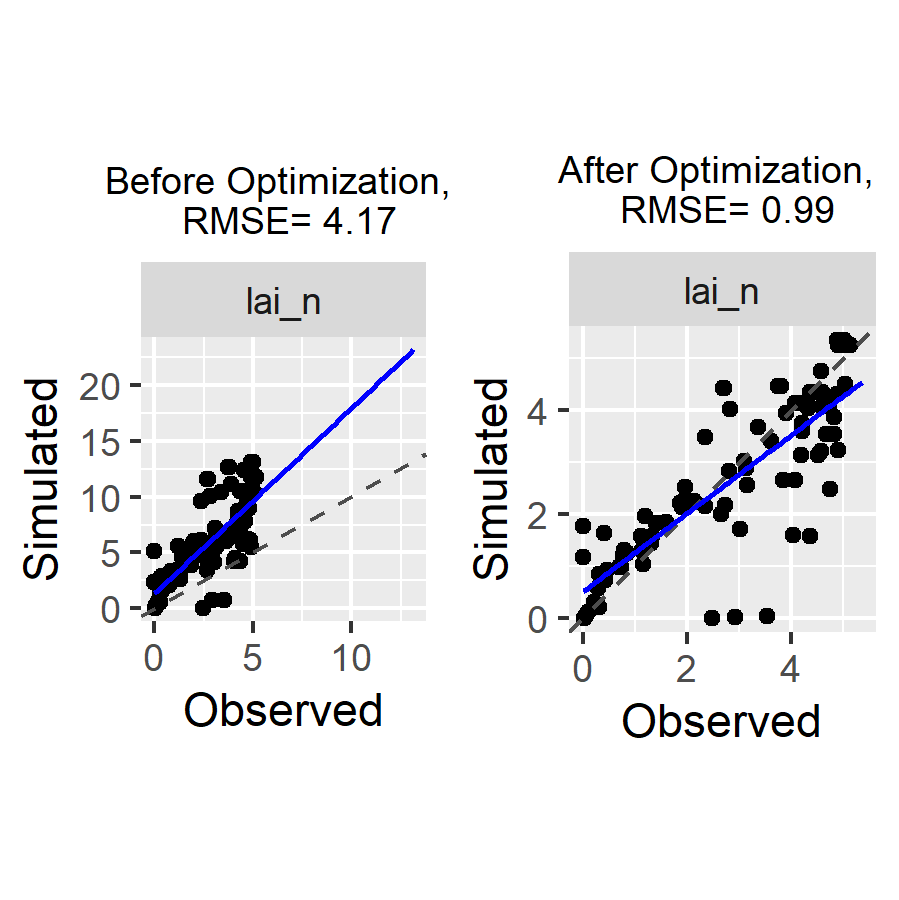Parameter estimation with the Stics crop Model: a case with specific and varietal parameters
Samuel Buis
2024-11-13
Source:vignettes/Parameter_estimation_Specific_and_Varietal.Rmd
Parameter_estimation_Specific_and_Varietal.RmdStudy Case
This document presents an example of a simultaneous estimation of one specific and one varietal parameter on a multi-varietal dataset using the Stics model, while a simpler introductory example is presented in this vignette (you should look at it first).
Data comes from a maize crop experiment (see description in Wallach et al., 2011). In this example, 8 situations (USMs in Stics language) will be used for the parameter estimation. This test case correspond to case 1c in (Wallach et al., 2011).
The parameter estimation is performed using the Nelder-Mead simplex method implemented in the nloptr package.
Initialisation step
This part is not shown here, it is the same as this of the introductory example.
Read and select the corresponding observations
In this example, observed LAI are used for all USMs for which there
is an observation file in javastics_workspace_path
folder.
# Read observation files
obs_list <- get_obs(javastics_workspace_path)
obs_list <-
filter_obs(
obs_list,
var = c("lai_n"),
include = TRUE
)Set information on the parameters to estimate
param_info allows handling specific / varietal
parameters (dlaimax vs durvieF parameters in this example):
dlaimax is defined to take the same value for all situations, whereas
durvieF is defined in such a way that it may take one value for
situations c("bo96iN+", "lu96iN+", "lu96iN6", "lu97iN+"),
that correspond to a given variety, and another for situations
c("bou99t3", "bou00t3", "bou99t1", "bou00t1"), that
correspond to another variety, sit_list being in this case
a list of size 2 (see code below). Please note that bounds can take
different values for the different groups of situations (lb and ub are
vectors of size 2 for durvieF).
param_info <- list()
param_info$dlaimax <-
list(
sit_list =
list(
c(
"bou99t3",
"bou00t3",
"bou99t1",
"bou00t1",
"bo96iN+",
"lu96iN+",
"lu96iN6",
"lu97iN+"
)
),
lb = 0.0005,
ub = 0.0025
)
param_info$durvieF <- list(
sit_list =
list(
c("bo96iN+", "lu96iN+", "lu96iN6", "lu97iN+"),
c("bou99t3", "bou00t3", "bou99t1", "bou00t1")
),
lb = c(50, 100),
ub = c(400, 450)
)Set options for the model
model_options <-
stics_wrapper_options(
javastics = javastics_path,
workspace = stics_inputs_path,
parallel = TRUE
)Set options for the parameter estimation method
optim_options <- list()
optim_options$nb_rep <- 7 # Number of repetitions of the minimization
# (each time starting with different initial
# values for the estimated parameters)
optim_options$maxeval <- 1000 # Maximum number of evaluations of the
# minimized criteria
optim_options$xtol_rel <- 1e-04 # Tolerance criterion between two iterations
# (threshold for the relative difference of
# parameter values between the 2 previous
# iterations)
optim_options$out_dir <- data_dir # path where to store the results
# (graph and Rdata)
optim_options$ranseed <- 1234 # random seedRun the optimization
The optimization is performed here with the Nelder-Mead simplex
method and crit_log_cwss criterion that are the default
values in the estim_param function for the
optim_method and crit_function arguments.
res <- estim_param(
obs_list = obs_list,
model_function = stics_wrapper,
model_options = model_options,
optim_options = optim_options,
param_info = param_info
)The estimated values of the parameters are the following:
res$final_values## dlaimax durvieF1 durvieF2
## 1.108991e-03 3.975518e+02 2.146185e+02The EstimatedVSinit.pdf file contains the following figures:
Figure 1: plots of estimated vs initial values of parameters dlaimax and durvieF (estimated for both varieties).
Compare simulations and observations before and after optimization
A piece of code to run the model with the values of the parameters before and after the optimization and to create a couple of plots using the CroPlotR package to check if the calibration reduced the difference between simulations and observations:
# Run the model without and with forcing the optimized values of the parameters
sim_before_optim <- stics_wrapper(model_options = model_options)
sim_after_optim <- stics_wrapper(
param_values = res$final_values,
model_options = model_options
)
stats <- summary(sim_before_optim$sim_list, obs = obs_list)
p <- plot(
sim_before_optim$sim_list,
obs = obs_list,
type = "scatter",
all_situations = TRUE
)
p1 <-
p[[1]] +
labs(title =
paste(
"Before Optimization, \n RMSE=",
round(stats$RMSE, digits = 2)
)
) +
theme(plot.title = element_text(size = 9, hjust = 0.5))
stats <- summary(sim_after_optim$sim_list, obs = obs_list)
p <-
plot(
sim_after_optim$sim_list,
obs = obs_list,
type = "scatter",
all_situations = TRUE
)
p2 <-
p[[1]] +
labs(title =
paste(
"After Optimization, \n RMSE=",
round(stats$RMSE, digits = 2)
)
) +
theme(plot.title = element_text(size = 9, hjust = 0.5))
p <- grid.arrange(grobs = list(p1, p2), nrow = 1, ncol = 2)
# Save the graph
ggsave(
file.path(
optim_options$out_dir,
paste0("sim_obs", ".png")
),
plot = p
)This gives:

Figure 2: plots of simulated vs observed LAI before and after optimization. The gap between simulated and observed values has been drastically reduced: the minimizer has done its job!